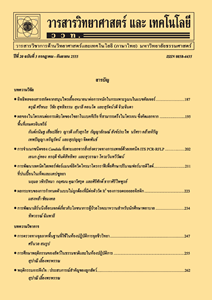การวิเคราะห์การใช้การไหลแบบควงสว่านที่ขับเคลื่อนโดยสนามไฟฟ้าเพื่อเพิ่มประสิทธิภาพการอบแห้งแบบใช้ลมร้อน
Main Article Content
Abstract
Abstract
This research aims to analyze the influences of electric-driven swirling flow on the enhancement of the hot-air drying efficiencies. Two ground wires are placed in the flow direction, while electrode wires are placed in the normal direction of flow. In addition, electrode positions respected to the surface of porous material are varied both in the normal direction with Ly = 2 and 4 cm and in the flow direction with Lx = 30 and 33.75 cm. High electrical voltage is tested at V = 5, 10, and 20 kV. The temperature and bulk mean velocity of hot air entering test section are controlled at 60 ºC and 0.33 m/s, respectively. In this study, a packed bed used as a porous material composes of water, air and 0.125-mm-diameter glass beads. The initial saturation of packed bed is Si = 0.5. It is found from experimental results when electric fields are exposed to hot-air flow, swirling flow is created in the plane normal to flow above the packed bed surface. When the electrical voltage is applied at V = 20 kV, surface temperature and the rate of moisture removal are rapidly increased, especially in the beginning period of drying. This is due to high moisture content in material. Higher drying efficiency is obtained when the electrodes are placed near the center of packed-bed surface (Lx = 33.75 cm). It is found from the flow visualization that pattern and location of the swirling depend on electrode positions. With the electrically-driven swirling flow, the drying rate is enhanced approximately 1.7 - 2 times, and the convective heat transfer coefficient is increased around 2 – 2.8 times.
Keywords: spiral flow; electric field; hot-air drying; enhancement of heat and mass transfer
Article Details
References
[2] Wang, W., Yang, L., Wu, K., Lin, C., Huo, P., Liu, S., Huang, D. and Lin, M., 2017, Regulation-controlling of boundary layer by multi-wire-to-cylinder negative corona discharge, Appl. Therm. Eng. 119: 438-448.
[3] Lai, F.C., and Zhang, J., 2011, Effect of emitting electrode number on the performance of EHD gas pump in a rectangular channel, J. Elect. 69: 486-493.
[4] Lee, J.R. and Lau, E.V., 2017, Effects of relative humidity in the convective heat transfer over flat surface using ionic wind, Appl. Therm. Eng. 114: 554-560.
[5] Yabe, A., Mori, Y. and Hijikata, K., 1978, EHD study of the corona wind between wire and plates electrodes, AIAA J. 16: 340-345.
[6] Lai, F.C. and Lai, K.W., 2002, EHD-enhanced drying with wire electrode, Drying Technol. 20: 1393-1405.
[7] Lai, F.C. and Wang, C.C., 2009, EHD-enhanced water evaporation from partially wetted glass beads with auxiliary heating from below, Drying Technol. 27: 1199-1204.
[8] Ahmedou, A.O., Rouaud, O. and Havet, M., 2009, Assessment of the electrohydro-dynamic drying process, Food Bioproc. Technol. 2: 240-247.
[9] Saenewong Na Ayuttaya, S., Chaktranond, C. and Rattanadecho, P., 2013, Numerical analysis of electric force influence on heat transfer in a channel flow (Theory based on saturated porous medium approach), Int. J. Heat Mass Trans. 64: 361-374.
[10] Aoki, K., Hattori, M., Kitamura, M. and Shiraishi, N., 1991, Characteristics of heat transport in porous media with water infiltration, ASME/JSME Therm. Eng. Proc. 4: 303-308.


